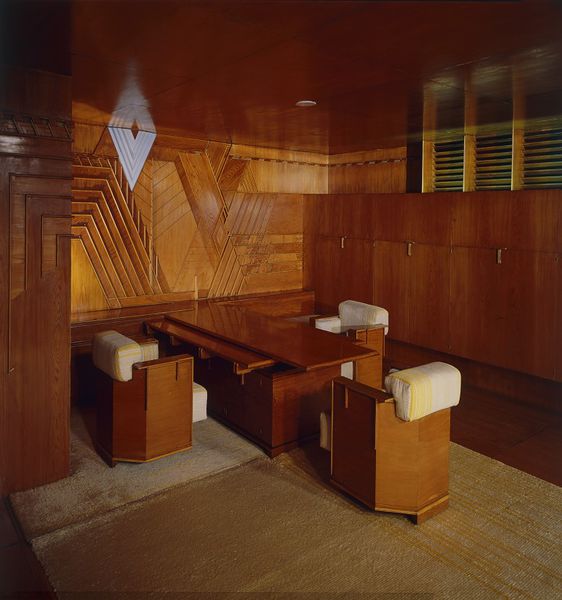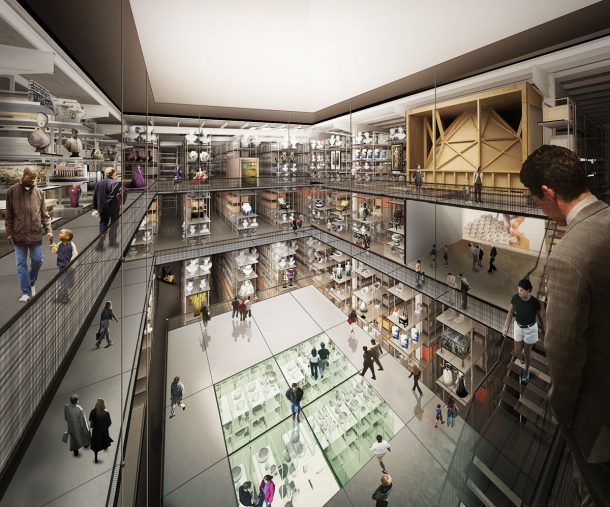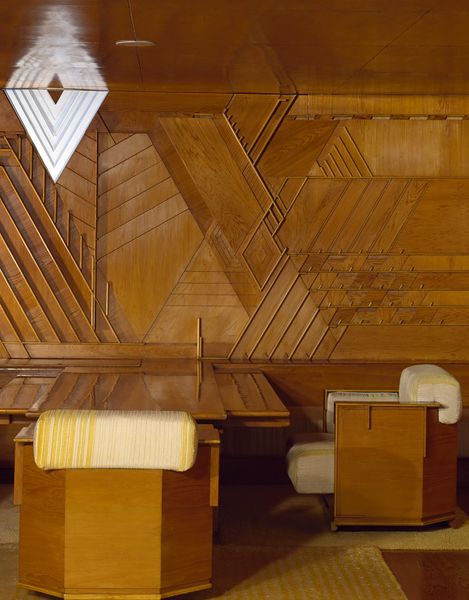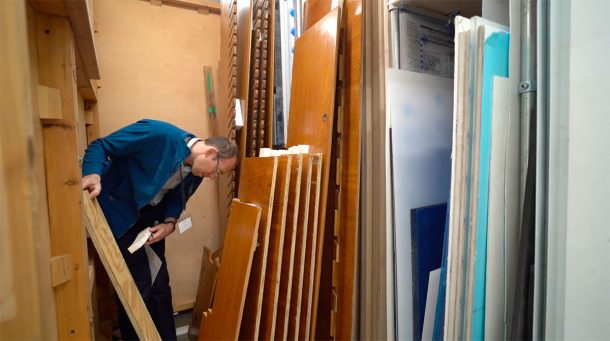This blog was co-authored by Becky Knott (Lead Curator CRC, V&A East) and Holly Harris (Project Co-ordinator, V&A East).
The last few months have been a very busy period for the V&A East team as we prepare for the opening of the new Collection and Research Centre (CRC) and Waterfront Museum in Stratford. One major milestone has been the completion of the conservation of the Kaufmann Office, a complete interior designed by the influential American architect Frank Lloyd Wright, ready for its display at the CRC in a few years’ time.

Designed by Diller Scofidio + Renfro, the new Collection and Research Centre at Here East will be a purpose-built home to house more than 250,000 objects and 917 archives. The centre will reinvent the idea of the museum store, and invite visitors on a behind-the-scenes journey through the stored collections to reveal how and why objects are collected, cared for, conserved and displayed. A central public collection hall will turn the store inside out, with a wide array of objects on display – from some of the smallest, ancient pottery fragments and jewellery, to some of the largest, including entire room sets and building fragments. A highlight of this journey will be the installation of the Kaufmann Office, which has not been on display for a number of years.

Frank Lloyd Wright (1867 – 1959) is widely considered to be the most important American architect of the 20th century and is known for designing buildings such as the Guggenheim Museum in New York and the Imperial Hotel in Tokyo. This office is one of Wright’s most successful and interesting projects, and was designed between 1935 – 37 for Edgar J. Kaufmann (1885 – 1995) for his Pittsburgh department store. Kaufmann was a prominent business man and, after meeting him in 1934, became a significant patron of Wright’s work. The V&A has many period rooms in its collections, but none of them are as authentic and original as the Kaufmann Office, and when this object goes back on display it will be the only Frank Lloyd Wright interior on display outside of the United States.

The office is a simple rectangular room made entirely of swamp cypress plywood panels. Wright was known for his interest in, and exploration of, new materials, and in the design of the office he demonstrates his love for plywood through its use across the entirety of the room’s floor and walls. The size and layout of the room is dictated by the standard plywood board size, and the material is used decoratively to create a spectacular abstract mural surrounding the desk. Wright believed that decoration should be of the surface, not on the surface, and so the design creates an organic focal point. Wright was also a strong advocate that the interior of a space, along with the building that housed it, should be a complete work of art, and therefore also took responsibility for the design of the furniture, upholstery and lamp. Kaufmann didn’t make any alterations to the space in the 20 years he used it, a testament to the success of the design.

The Office is 85 years-old and since it was removed in 2005 from long-term display at the V&A in South Kensington parts of the room have been loaned to institutions worldwide and others put into storage. Ahead of its reinstallation at the CRC, the office needed some conservation to ensure its long-term stability and safety. Although a team of specialist furniture conservators are based at the museum, we don’t have the space in South Kensington for such a large-scale conservation project. At the beginning of this year the office was moved to the studio of Plowden and Smith, a London-based conservation studio, to enable the cleaning, consolidation and partial reconstruction of the office.

The conservation of an object this big is a wonderful opportunity to understand its construction up-close. The office comprises some 240+ pieces of plywood, which tends to delaminate over time, and so the focus of practical conservation work was on the consolidation of the delicate layers of wood veneer. The conservation was also an important opportunity to get detailed information about the dimensions and the construction of the office to inform aspects of the design and build of the CRC. Together with conservators at Plowden & Smith, trial assemblies of office sections were completed so that we could understand the spatial experience of our future visitors.

Although COVID-19 caused some delay, the conservation of the office is now complete, and it is ready to be installed. At the entrance to the room a section of the floor will be replaced with a replica, and so – once open – visitors will be able to enter inside to view the office and once again experience it as a piece of architecture.
The V&A is grateful to the TEFAF Museum Restoration Fund for its contribution to the conservation of Frank Lloyd Wright’s Kaufmann Office.



Thanks Becky for sharing this interesting update and photos. I never saw the office before it was removed from display, so I’m really keen to experience it when the CRC opens.
Beautiful pictures. Edgar was my father’s uncle, his sister was my grandmother, Martha Kauffman Wolf. Edgar died in 1954, the year before my grandfather Wolf. I can’t wait to see the office again. I only remember seeing it in person once at the Kaufmann’s Department Store. Edgar was sitting at his desk. I was probably only around 11 or 12 years old.
The Kaufmann office shows Frank Lloyd Wright at his more commercial, flirting with the 1930s international style (what we now call Art Deco), and I, like many, can’t wait to actually step inside this interior. Thank you for making it an immersive experience – just as Wright would have wanted.